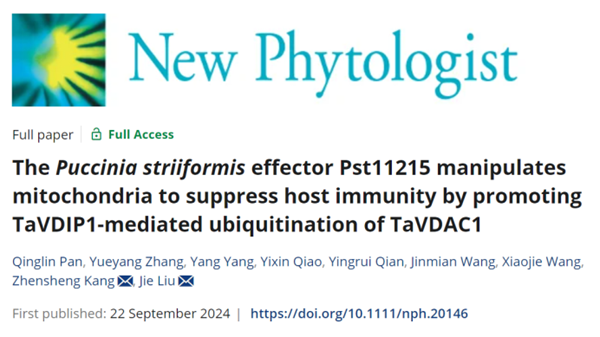Puccinia striiformis rust, one of the most significant diseases affecting wheat production, poses a severe threat to wheat production security. The causative pathogen, Puccinia striiformis, is an obligate biotrophic fungus that secretes effector proteins to suppress host immunity and facilitate infection and disease development. Mitochondria, as crucial organelles in cells, have significant impacts on plant immune function through changes in their morphology, metabolism, and function. Mitochondria-induced cell death is closely related to plant disease resistance. However, the molecular mechanisms by which pathogens manipulate mitochondria to suppress host immunity remain largely unknown.

Recently, the Plant Immunity Research Team from our college published an online research paper titled "The Puccinia striiformis effector Pst11215 manipulates mitochondria to suppress host immunity by promoting TaVDIP1-mediated ubiquitination of TaVDAC1" in New Phytologist. This study found that the effector protein Pst11215 is a key virulence factor in the infection and disease development of Puccinia striiformis. It interacts with the mitochondrial voltage-dependent anion channel protein TaVDAC1. Additionally, the E3 ubiquitin ligase TaVDIP1 targets and ubiquitinates TaVDAC1, promoting wheat susceptibility to disease. Analysis of the regulatory mode among these three proteins revealed that during Puccinia striiformis infection of wheat, the effector protein Pst11215 may alter the channel structure of TaVDAC1 by promoting its ubiquitination by TaVDIP1, accelerating the efflux of reactive oxygen species (ROS) from mitochondria to the cytoplasm, where they are scavenged by cytosolic antioxidant enzymes. This process mitigates ROS damage to mitochondria, maintains cellular homeostasis, and simultaneously inhibits immune-induced cell necrosis, thereby facilitating Puccinia striiformis infection.
Academician and Professor Kang Zhensheng, and Professor Liu Jie from the Plant Immunity Team are the co-corresponding authors of this paper, and doctoral student from our college, Pan Qinglin is the first author. The experimental platform of the State Key laboratory for Crop Stress Resistance and High-Efficiency Production provided technical support for the completion of this paper. This research was funded by the National Key Research and Development Program, the National Natural Science Foundation of China, and the Shaanxi Provincial Natural Science Basic Research Program.

Original link: http://doi.org/10.1111/nph.20146